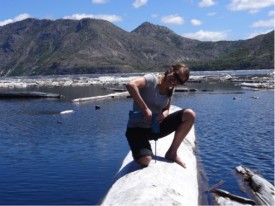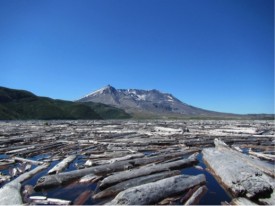by Jim Gawel, Assoc. Prof. of Environmental Chemistry and Engineering, School of Interdisciplinary Arts and Sciences, University of Washington Tacoma
It’s an odd question, but an intriguing one. Natural disturbances such as landslides, high winds, and streambank erosion can add significant amounts of floating woody debris to lakes. However, humans often remove this material for salvage logging or to prevent boat damage in accessible lakes. The role of floating woody debris in lakes has been largely ignored in the study of lake ecosystems. But this floating platform is a substrate for the production of biomass like biofilms and periphyton, and thus may play an important role in biological productivity, especially in more oligotrophic lakes.
Dr. Jim Gawel and his undergraduate research team, Shantelle Reamer, Julieann Palumbo and Jessica West, are working this summer in Spirit Lake, in the shadow of Mount St. Helens, to address this question. Volcanic eruptions are another episodic natural disturbance that may contribute floating woody debris to lakes. The 1980 eruption of Mount St. Helens, and the associated massive landslide, deposited enormous amounts of floating woody debris in Spirit Lake, where much of it still floats today. The floating log mat, which covers over 2 km2 when packed together, not only provides a substrate for biological production, it is also the source of nutrient and carbon inputs to the water column as the logs constantly rub against each other.

Figure 2: Shantelle Reamer working on the instrumentation of a floating log on Spirit Lake. Many of the logs are big enough that they are completely stable to work on even when afloat.
Gawel and his team are currently installing suspended sediment traps on these logs to collect the material shed and estimate the contribution of the log mat to the nutrient budget of Spirit Lake. This experiment is quite challenging as it requires the right wind conditions and a good bit of log moving to collect the samples each month. Gawel’s crew is also taking time-lapse images of the log mat’s position to tie to sedimentation rates observed in different parts of the lake. This research may be the first to investigate the role of floating logs on lake productivity and thus can inform future management of lakes in forested catchments. The initial results from this study will be presented at this fall’s WALPA Annual Conference in Chelan.











